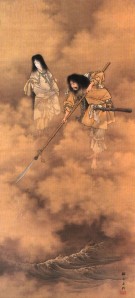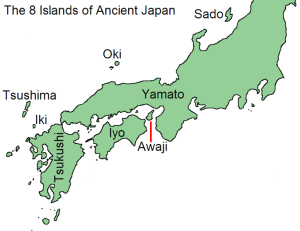As discussed in the previous
post, the Devtas were greatly depleted of their powers due to the curse on Indra by Sage Durvasa. The Asuras thought of this as the most opportune time to strike and attacked Swarga.
The Devtas were outclassed by the Asuras on the battlefield and had to flee to save their lives. They approached Lord Brahma to help them.
Lord Brahma in turn directed the Devtas to Lord Vishnu.
The sixth Manu (more on this term later) was Caksusha, the son of Cakshu Manu. During the reign of this Manu, Mantradruma was Indra. The wife of Vairaja, whose name was Devasambhuti, gave birth to an incarnation of Lord Vishnu named Ajita (meaning invincible).
Lord Vishnu (Ajita) advised the Devtas to make a peace proposal to the Asuras, so that after formulating a truce, the Devtas and Asuras could churn the ocean of milk (
ksheer sagar) for Amrita. The rope would be the biggest serpent, known as
Vasuki, and the churning rod would be
Mandara Mountain.
[caption id="attachment_605" align="aligncenter" width="221"]
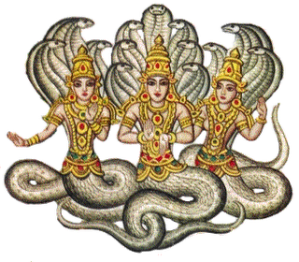
Vasuki[/caption]
He directed that all sorts of medicinal herbs should be cast into the sea of milk and then taking the mountain Mandara for the churning-stick and the serpent Vasuki for the rope the ocean should be churned.
Following the instructions of Lord Vishnu the Devtas joined hands with Maharaja Bali, the King of the Asuras. Then both the Asuras and the Devtas started for the ocean, taking Mandara Mountain with them. Because of the great heaviness of the mountain, the Devtas and Asuras soon became fatigued, and some of them even died.
[caption id="attachment_603" align="aligncenter" width="300"]
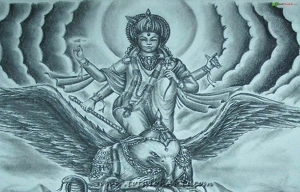
Lord Vishnu and Garuda carrying Mandara mountain[/caption]
To help with lifting of the Mandara Mountain,Lord Vishnu appeared on the back of his carrier, Garuda, and placed it on the back of Garuda. Garuda along with Vishnu carried the mountain to the spot of the churning and placed it in the middle of the sea. Then Vishnu asked Garuḍa to leave that place because as long as Garuda was present, Vasuki (a snake) could not come there.
Lord Brahma was requested to sit on top of the Mandara Mountain to provide balance. The Devtas and Asuras then summoned Vasuki, king of the serpents. They coiled Vasuki around Mandara Mountain as a churning rope.
The leaders of the Asuras thought it unwise to hold the tail, the inauspicious portion of the snake and protested that they wanted to hold the front of the snake. The Devtas agreed to this demand.
[caption id="attachment_607" align="aligncenter" width="300"]
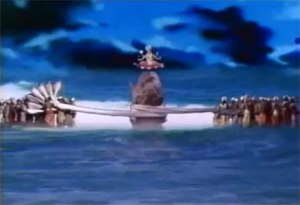
Asuras and Devtas all set to begin the Samudra Manthan[/caption]
After thus adjusting how the snake was to be held, the sons of Kashyapa, both Devtas and Asuras, (a post on this will follow soon) started the process of churning the ocean of milk.
The Mandara Mountain had no support, and therefore although held by the strong hands of the Devtas and Asuras, it sank into the water.
[caption id="attachment_600" align="aligncenter" width="261"]
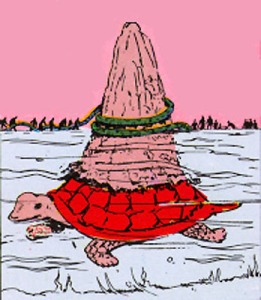
Kurma Avatar[/caption]
This is when Lord Vishnu took his Kurma Avatar and taking the shape of a tortoise, entered the water, and lifted the great Mandara Mountain. The mountain rested on the back of the great tortoise, which extended for eight hundred thousand miles like a large island.
Such is the leela of Lord Vishnu that the rolling of the mountain on the tortoise was just a means of scratching his body, and thus he felt a pleasing sensation.
This action by Lord Vishnu enlivened and energised the Devtas and Asuras and the churning of the samudra resumed.
Vasuki had thousands of eyes and mouths. From his mouths he breathed smoke and blazing fire, which affected the Asuras, headed by Pauloma, Kaleya, Bali and Ilvala. Thus the Asuras gradually became powerless.
After struggling for years, the first item to come out of the ocean was
halahala (poison).
[caption id="attachment_608" align="aligncenter" width="212"]
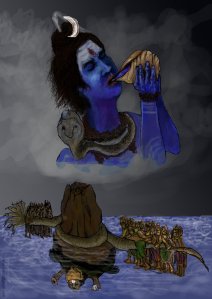
Lord Siva drinking the Halahala[/caption]
The poison was so venomous that the whole world started getting inflamed by it. This
halahala was the most vicious and venomous poison of universe and it started killing both sides. As no one could bear the poisonous fumes emitted by the poison, both Devas and Asuras began to collapse due to asphyxiation. They ran for help to Brahma, who looked to Vishnu for advice. Vishnu said that only Shiva could digest the deadly poison. So both parties went to Kailasha and prayed to Lord Shiva for help. Shiva chose to consume the poison and thus drank it. His wife Parvati, alarmed, stopped it in his throat with her hands, thus earning him the name
Vishakantha (the one who held poison in his throat). The poison made his throat turn blue; hence, he is also known as
Nilakantha (the one with a blue throat).
Gosaikunda lake is believed to have formed from the digging of the land by the Trishul of Lord Shiva, as after he drank the poison, he desperately wanted cold water to quench the thirst generated due to overwhelming heat of the poison.
It is believed that the scorpions, cobras, poisonous drugs and other animals whose bites are poisonous took the opportunity to drink whatever little poison had fallen and scattered from Lord Shiva's hand while he was drinking.
After the halahala was consumed by Lord Shiva thus saving everyone’s lives, the Devtas and Asuras once again resumed churning the ocean with renewed vigour.
[caption id="attachment_609" align="aligncenter" width="300"]
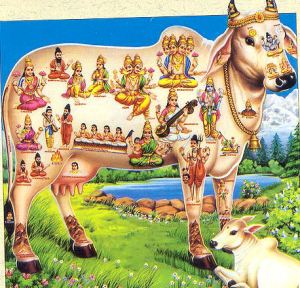
Kamadhenu or Surabhi[/caption]
After some time a cow known as
Kamadhenu or
Surabhi appeared. Great sages who were completely aware of the Vedic ritualistic ceremonies took charge of the Surabhi cow, which produced all the yogurt, milk and ghee absolutely necessary for offering oblations into the fire.
[caption id="attachment_610" align="aligncenter" width="178"]

Uchaishravas[/caption]
The next thing to emerge from the samudra was a horse named
Uccaihsrava, a seven-headed flying horse. Bali Maharaja desired to possess this horse, and Indra agreed.
[caption id="attachment_611" align="aligncenter" width="264"]

Airavata[/caption]
The next thing to be generated was eight great he-elephants headed by
Airavata and eight she-elephants, headed by Abhramu. Indra decided to have Airavata as his mount. Abhramu became the wife of Airavata.
After the elephants came the celebrated gems
Kaustubha-mani and
Padmaraga-mani. The Devtas and Asuras decided to gift the
the most valuable jewel in the world, the Kaustubha-mani to Lord Vishnu.
[caption id="attachment_612" align="aligncenter" width="300"]
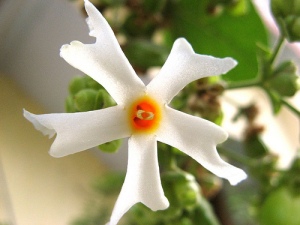
Parijat flower[/caption]
Generated next was the
Parijat flower, a divine flowering tree with blossoms that never fade or wilt. The Parijat tree was taken to Indraloka by the Devas.
[caption id="attachment_613" align="aligncenter" width="222"]

Apsaras[/caption]
Next there appeared the
Apsaras lead by
Rambha,
Menaka,
Punjisthala etc. They were fully decorated with golden ornaments and lockets and were dressed in fine and attractive clothing. They chose the Devtas as their companions.
[caption id="attachment_614" align="aligncenter" width="193"]

Goddess Lakshmi[/caption]
Then there appeared the Goddess of fortune,
Lakshmi. She accepted Lord Vishnu as her eternal consort.
Next appeared
Varuni or
Sura, the Goddess and creator of alcohol which was claimed by the ignorant Asuras.
In addition to the above mentioned treasures which came from the samudra manthan, according to different sources of literature the following items are also attributed to have come out of the ksheera sagar.
1) A powerful bow - symbolic of the demon's belligerence.
2) Chandra, the moon which adorned Shiva's head
3) Shankha Vishnu's conch
4) Jyestha - the Goddess of misfortune
5) The umbrella taken by Varun
6) Earrings given to Aditi, by her son Indra
7) Tulasi plant
8) Nidra (sloth)
The Devtas and Asuras started becoming impatient as a lot of things had come out of the manthan except the one they had started out to obtain.
So finally when a strongly built man emerged out of the sagara carrying a jug filled to the top with
Amrita the joy of Devtas and Asuras knew no bounds.
[caption id="attachment_615" align="aligncenter" width="225"]
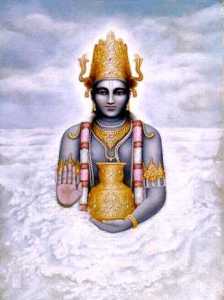
Dhanvantari emerging with Amrita[/caption]
This person was
Dhanvantari (who is considered an Avatar of Vishnu). He became the physician of the Devas and the God of Ayurvedic medicine.
Upon seeing Dhanvantari carrying the jug of nectar, the impatient Asuras, desiring the jug and its contents, immediately snatched it away by force.
This resulted in a fierce fight between Devas and Asuras for the nectar. It is believed that during this struggle for the
kumbha of
Amrita four drops of nectar fell at four places –
Allahabad or
Prayag (Uttar Pradesh),
Haridwar (Uttrakhand),
Ujjain (Madhya Pradesh) and Nasik (Maharashtra). A Kumbh Mela is celebrated at the four places every twelve years for this reason.
[caption id="attachment_616" align="aligncenter" width="300"]
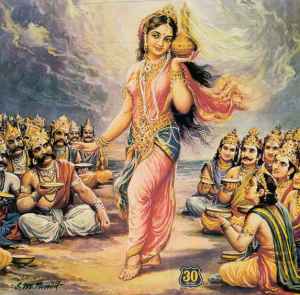
Mohini - female Avatar of Lord Vishnu[/caption]
At this moment, Lord Vishnu took the form of a beautiful and enchanting damsel,
Mohini to bail the Devtas out. She mesmerised the Asuras with her beauty and fooled them to give her the Amrita saying that she would distribute the Amrita amongst the Asuras and Devtas in a fair manner.
[caption id="attachment_617" align="aligncenter" width="233"]
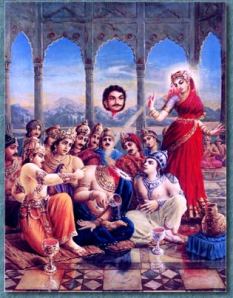
Mohini beheading Rahu[/caption]
The distracted Asuras were so lost in the beauty of Mohini that they didn’t even realise that Mohini was distributing the Amrita among the Devas and not the Asuras. Rahu understood what was happening and disguising himself as a Deva went and sat amongst the Devtas. Due to their luminous nature, Surya and Chandra noticed the switching of sides. They immediately informed Mohini. But before the nectar could pass his throat, Mohini cut off his head with the Sudarshana Chakra. However as the nectar had gone down his throat he did not die. From that day, his head was called Rahu and body was called Ketu who became planets later.
Another battle took place between the Devtas and the Asuras. And this time, rejuvenated with the Amrita, the Devtas handed a huge defeat to the Asuras.
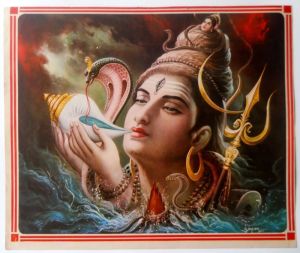 Lord Shiva drinking Halahala[/caption]
Lord Shiva drinking Halahala[/caption]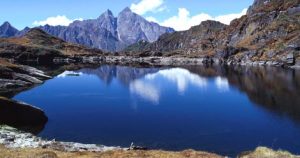 Gosaikunda Lake[/caption]
Gosaikunda Lake[/caption]
